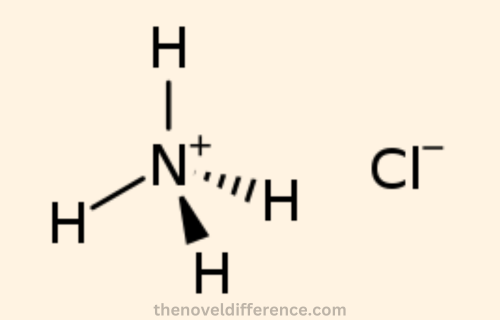Overview of normal salt and acid salt
Normal Salt (Neutral Salt): Normal or neutral salt is a type of compound produced by combining positively charged cations (cationic) with negatively charged anions (anionic). The reaction that creates normal or neutral salt results in its creation. It is called “normal” because its pH level is neutral, around 7. Normal salts are commonly found in nature and have various industrial, culinary, and medicinal applications. Normal salts are sodium chloride (table Salt), potassium chloride, and calcium carbonate.
Acid Salt: Also referred to as hydrogen salt or acidic salt, acid salt is a type of compound salt with both acidic and basic properties. It is formed when an acid reacts with a base, resulting in a salt that has an acidic nature. Acid salts typically have a lower pH level than normal salts, indicating their acidity. They can be formed through partial neutralization reactions, where not all of the acid is neutralized. Examples of acid salts include sodium dihydrogen phosphate and ammonium hydrogen sulfate.
Differences between Normal Salt and Acid Salt:
- pH Level: Normal salts have a pH level close to 7, indicating neutrality, while acid salts have a lower pH level, indicating their acidic nature.
- Composition and Chemical Structure: Normal salts are formed by the complete neutralization of an acid and a base, resulting in a balanced combination of cations and anions. Acid salts, on the other hand, contain excess acid due to incomplete neutralization, resulting in an unbalanced combination of ions.
- Solubility in Water: Normal salts are generally highly soluble in water, while acid salts may vary in their solubility. Some acid salts are highly soluble, while others may have limited solubility.
- Conductivity: Normal salts, when dissolved in water, can conduct electricity due to the presence of dissociated ions. Acid salts also exhibit conductivity, but their levels may vary depending on the strength of the acid component.
- Culinary and Industrial Applications: Normal salts are widely used for seasoning, food preservation, and various industrial processes. Acid salts find applications in food preservation, pharmaceuticals, and as cleaning agents due to their acidic properties.
Understanding the difference between normal salt and acid salt is crucial in various contexts, including health implications, industrial processes, and culinary considerations, as it allows for informed decision-making and appropriate utilization of these salts.
Definition of Salt
Salts are chemical compounds composed of positively charged cations (cations) and negatively charged anions (anions), linked together through an exchange process to form neutral products known as salts.

NaCl, more commonly known as table salt, is perhaps the best-known variety but other combinations between various cations and anions may produce multiple kinds of salt.
Salt is an inorganic material with crystalline structures and can usually be found in solid form. It may occur naturally as mineral deposits such as halite or rock salt deposits or produced industrially through processes like evaporation and mining, making its presence essential in numerous biological processes.
Being widely utilized for food seasoning, preservation, chemical production, water treatment applications as well as many industrial and domestic uses – its unique flavor makes it essential in global culinary practices!
Importance of understanding the difference between normal salt and acid salt
Understanding the difference between normal salt and acid salt is important for several reasons:
- Health Consequences: Regular salts and acid salts can have differing impacts on our bodies. According to studies, consumption of sodium chloride and regular salt has been linked with high blood pressure. On the other hand, acid salts, which may contain excess acid, can potentially cause irritation or digestive discomfort in some individuals. By understanding these differences, individuals can make informed choices about their salt intake and minimize potential health risks.
- Culinary Considerations: Normal salt and acid salt can have distinct effects on the taste and flavor of food. Normal salt, like sodium chloride, is commonly used to enhance the taste of dishes and balance flavors. Acid salts such as citric or tartaric acids add a tangy or tart flavor to foods, providing them with their distinctive sour or tart flavors. Understanding the properties and effects of these salts can help in achieving the desired flavors in culinary preparations.
- Food Preservation: Acid salts can help preserve food by inhibiting microorganism growth. They create an acidic environment that prevents the growth of bacteria, yeasts, and molds. Knowing when and how to use acid salts in food preservation can help extend the shelf life of perishable food items and maintain their safety.
- Industrial Applications: Understanding the differences between normal salt and acid salt is important in various industrial processes. Different salts contain unique qualities that make them appropriate for certain applications. For instance, normal salts are commonly used in chemical manufacturing, water treatment, and metallurgy industries. Acid salts find applications in pharmaceuticals, cleaning agents, and certain manufacturing processes. Knowing these differences enables the appropriate selection and utilization of salts in industrial settings.
- Environmental Impact: The use of different salts can have varying impacts on the environment. For example, excessive use of normal salts in agricultural practices can contribute to soil salinity, which negatively affects plant growth and overall ecosystem health. Being aware of the differences between normal salt and acid salt can help in implementing sustainable practices and minimizing environmental consequences.
Understanding the difference between normal salt and acid salt is crucial for making informed decisions regarding health, culinary practices, food preservation, industrial applications, and environmental impact.
This knowledge empowers individuals and industries to use the appropriate salt types in various contexts, promoting overall well-being and sustainability.
Normal Salt
Neutral salt refers to any form of salt with an ideal neutral pH level — typically 7.
It forms during neutralization when an acid and base react with each other to form salt and water molecules that combine chemically in an equilibrium state, creating balanced compounds composed of positively charged cations (cations) and negatively charged anions (anionic ions) that combine to form chemical compounds with similar characteristics that provide stability over time.
NaCl, more commonly used as table salt, is one of many traditional salts with various chemical compositions and properties that is classified as normal salts. Composed of sodium cations (Na+) and chloride anions (Cl-), this traditional form can also contain various other cations and anions for different chemical compositions and properties.

Normal salts are solids that dissolve easily in water. Once in suspension, they dissociate into their constituent ions to conduct electricity as well as exhibit other unique properties like pH neutrality and crystal structure.
They have many applications ranging from culinary uses for seasoning food preservation purposes and flavor enhancement, industrial uses in manufacturing processes as well as medicinal and healthcare purposes.
Note that while normal salt consumption is generally considered safe, excessive consumption could have adverse health impacts related to sodium consumption and blood pressure regulation. Therefore, it’s recommended to consume salt in moderation and adhere to a balanced diet for best results.
Acid Salt
An acid salt (sometimes referred to as hydrogen salt or acidic salt ) is a type of sodium chloride with acidic properties. As opposed to regular salts which have neutral pH levels, which indicate neutrality; instead, acid salts have lower pH values which indicate their acidity.
Acid salts form when an acid reacts with the base but doesn’t completely react, leaving excess acidity present in its resultant salt form.
Acid salts form when an acid reacts with its base in an incomplete neutralization reaction, leaving some acidic properties intact in the form of an acid component present in its final form – giving the salt its acidity, giving its taste its unique tart flavor, and acting as an acid in various chemical processes.
Of all of the acid salts known to us, two examples stand out as examples: sodium dihydrogen phosphate (NaH2PO4) and ammonium hydrogen sulfate (NH4HSO4) are both popular examples; both consist of both cations and anions from their reaction with acid, with their anions coming directly from it.
Acid salts vary significantly when it comes to their solubility in water or other solvents as well as physical characteristics like crystal structure or physical appearance.

Acid salts’ acidic properties make them useful in many different applications, from food preservation and flavor enhancers, acidifiers, and flavor enhancers to pharmaceutical applications and cleaning agents that require acidity.
Food preservation applications involve acid salts inhibiting bacteria and microorganism growth due to their acidity; acidifiers serve to enhance food and beverage products as an acidifier while flavor enhancers can also use these acid salts as acidifiers and flavor enhancers.
Furthermore, their solubility characteristics and chemical composition could prove advantageous while pharmaceutical applications require them for specific chemical properties and solubility characteristics while cleaning agents and industrial uses that require acidity such as cleaning agents where acidity is necessary.
Acid salts should be handled and applied appropriately and adhere to safety standards; their acidic nature may impact handling, storage, and usage; therefore it’s vitally important that their properties and characteristics be understood for safe application in various contexts.
Differences Between Normal Salt and Acid Salt
The key differences between normal salt and acid salt can be summarized as follows:
- pH Levels: Normal salt typically has an ideal neutral pH level between 7 and 8, while acid salt has lower pH levels to indicate its acidity. Normal salt does not have an acidic or alkaline effect on a solution, whereas acid salt contributes acidity to a solution.
- Composition and Chemical Structure: Normal salt is formed through a complete neutralization reaction between an acid and a base, resulting in a balanced combination of cations and anions. On the other hand, acid is formed through a partial neutralization reaction, leaving excess acid in the salt. This imbalance in ions contributes to the acidic nature of acid salts.
- Solubility in Water: Normal salts are generally highly soluble in water, as they readily dissociate into their constituent ions. Acid salts can vary in their solubility, depending on their specific chemical composition. Some acid salts are highly soluble, while others may have limited solubility in water.
- Conductivity: When dissolved in water, normal salts readily dissociate into ions, making them capable of conducting electricity. Acid salts also exhibit conductivity when dissolved, but their levels of conductivity may vary depending on the strength of the acid component.
- Culinary and Industrial Applications: Common salts such as sodium chloride (table salt) are frequently employed for seasoning and food preservation due to their ability to add flavor while serving as preservatives. Acid salts find applications in food preservation, as their acidic properties inhibit the growth of microorganisms. Acid salts have numerous applications across numerous industrial processes, from pharmaceuticals and cleaning agents to specific manufacturing applications.
What are the similarities Between Normal Salt and Acid Salt?
While normal salt and acid salt have distinct differences, there are some similarities between the two:
- Chemical Composition: Both normal salt and acid salt are composed of ions. The difference lies in the balance of these ions and the presence of excess acid in acid salts.
- Solid State: Both normal salt and acid salt are typically found in solid form. They often crystallize and have a crystalline structure. This solid state allows for their convenient handling, storage, and usage.
- Formation through Chemical Reactions: Both normal salt and acid salt are formed through chemical reactions. Normal salt is formed through a complete neutralization reaction between an acid and a base, resulting in a balanced combination of ions. On the other hand, acid is formed through a partial neutralization reaction, leaving excess acid in the salt.
- Solubility in Water: Both normal salt and acid salt are soluble in water to varying degrees. Normal salts, in general, have high solubility in water, readily dissociating into their constituent ions. Acid salts may also be soluble, though their solubility will depend upon their specific chemical makeup.
- Culinary and Industrial Applications: Both normal salt and acid salt find applications in culinary practices and various industries. Normal salt is commonly used for seasoning, flavor enhancement, and food preservation. Acid salts are also used in food preservation due to their ability to inhibit the growth of microorganisms. They also have industrial applications in areas such as pharmaceuticals, cleaning agents, and specific manufacturing processes.
While normal salt and acid salt have these similarities, it is important to note that their distinct differences, such as pH level, chemical composition, and effects, have significant implications for their usage and applications.
Understanding both their similarities and differences is crucial in utilizing them appropriately in various contexts.
Normal Salt vs Acid Salt in Tabular Form
Sure! Here’s a comparison of normal salt and acid salt in tabular form:
| Normal Salt | Acid Salt | |
|---|---|---|
| pH Level | Neutral (around 7) | Acidic (lower than 7) |
| Formation | Complete neutralization of acid and base | Partial neutralization with excess acid |
| Composition | A balanced combination of cations and anions | Imbalanced combination with excess acid |
| Solubility in Water | Generally highly soluble | Solubility may vary depending on the salt |
| Conductivity | Conducts electricity when dissolved | Conductivity varies depending on the acid |
| Culinary Applications | Seasoning, flavor enhancement, preservation | Food preservation, flavor enhancement |
| Industrial Applications | Industrial processes, manufacturing | Pharmaceuticals, cleaning agents, etc. |
| Health Implications | Excessive intake can impact blood pressure | May cause irritation or digestive discomfort |
| Environmental Impact | Excessive use can contribute to soil salinity | Variable impact depending on the salt |
Importance of Understanding the Difference between Normal Salt and Acid Salt
It is important to understand the difference between acid and normal salt for several reasons:
- Acid salts and normal salts can have different health effects: High sodium levels in normal salt can cause health problems such as high blood pressure or cardiovascular disease. Acid salts, on the other hand, may cause irritation or digestive discomfort in some individuals. Understanding these differences helps individuals make informed choices about their salt intake and minimize potential health risks.
- Culinary Applications: Normal salt and acid salt have distinct effects on the taste and flavor of food. Normal salt is commonly used to enhance flavors and balance tastes in culinary preparations. Acid salts, with their acidic nature, provide a sour or tangy taste to foods. Understanding the properties and effects of these salts allows chefs and home cooks to achieve the desired flavors in their dishes.
- Food Preservation: Acid salts, due to their acidity, can be used in food preservation. The vinegar’s acidity inhibits the growth of bacteria, yeasts, and molds. This extends the shelf-life of perishable foods. Understanding which acid salts are suitable for specific preservation purposes can help maintain the safety and quality of preserved foods.
- Industrial Applications: Different salts have specific properties that make them suitable for various industrial processes. In industries like chemical manufacturing, water purification, and metallurgy, normal salts are used extensively. Acid salts find applications in pharmaceuticals, cleaning agents, and specific manufacturing processes. Understanding the differences helps in selecting the appropriate salt for specific industrial applications, ensuring optimal results.
- Safety and Handling: Recognizing the distinctions between regular salt and acid salt is crucial for safe handling and usage. Acid salts, being acidic, may require specific precautions to prevent harm or adverse reactions. Understanding their properties allows for safe handling and reduces the risk of accidents or mishaps.
- Environmental Impact: The use of different salts can have varying impacts on the environment. The excessive use of salt, such as normal salt, in agricultural practices can negatively impact plant growth and ecosystem health. Understanding the differences between normal salt and acid salt helps implement sustainable practices and minimize environmental consequences.
Understanding the difference between normal salt and acid salt enables individuals to make informed decisions regarding their usage, promoting health, safety, and sustainability in various contexts.
Conclusion
Understanding the difference between normal salt and acid salt is essential for various reasons. It allows individuals to make informed choices regarding their salt intake, promoting better health outcomes.
It helps chefs and home cooks achieve desired flavors in culinary preparations. Understanding the properties and effects of these salts enables their safe and appropriate use in food preservation and various industrial applications.
